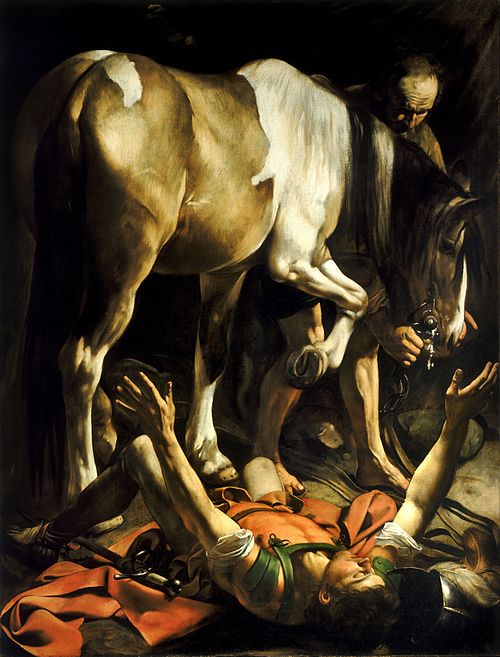Caravaggio is widely recognised as a master of the chiaroscuro technique, a painting style that explores the dramatic contrast between light and shadow to create depth and visual impact. This play of illumination is not merely an aesthetic resource, but also a powerful narrative device used to emphasise emotions, highlight figures, and suggest movement within the composition. The masterful use of this technique means that his works convey an intense, almost theatrical realism, drawing the viewer into the depicted scene.

The central scene in Caravaggio’s work shows Saul fallen to the ground, captured in a moment of rupture and transformation. Whenever divine light manifests in the painter’s works, it is accompanied by an element of turmoil, whether physical or psychological. In the case of Saul, this turmoil is expressed through the fall of his horse, a visible sign of his defeat and of the irresistible force of God’s grace. The light not only illuminates the scene but projects itself directly onto Saul, reinforcing his role as the chosen one of Christ in that decisive moment.
Another significant detail in the composition is Saul’s posture. He is fallen, helpless, and blind, a clear representation of human fragility in the face of the divine call. Caravaggio depicts him in a state of total surrender, incapable of relying on his own strength or will. This image conveys a profound theological message: the man who acts solely according to his own designs ultimately becomes powerless. His physical blindness symbolises the spiritual blindness he possessed before his encounter with Christ. The horse, in a threatening movement, raises its hoof as if it might trample him, further emphasising his vulnerability.
Moreover, the reaction of those accompanying Saul is revealing. The man beside him shows neither surprise nor reverence, but rather appears indifferent to what has just occurred. This figure represents those who, even while witnessing an extraordinary event, fail to grasp its depth. It is a parallel with the experience of conversion: those who undergo an encounter with God feel a radical change, but often those around them cannot understand or accept this transformation.
Another important detail in the painting is the presence of the sword next to Saul. This element is not there by chance. In various later Christian depictions, Saint Paul is portrayed holding a sword, a symbol of his doctrinal authority and his role as a soldier of Christ. The sword also alludes to his future evangelising mission, marked by the use of the word as a weapon in the fight for faith.
In addition to the sword, Saul’s attire also deserves attention. Caravaggio paints him wearing garments similar to those of Roman soldiers, clean-shaven and with short hair. This aesthetic choice makes him appear more like a Roman citizen than a Pharisaic Jew, his original identity. The intention may be to emphasise his dual citizenship and his later mission to evangelise both Jews and Gentiles. The absence of a beard may also suggest his youth and impetuousness before his conversion.
Caravaggio’s genius lies in the way he transforms a biblical narrative into a scene of visual and emotional impact. The composition of the work does not merely depict a historical event but communicates the spiritual message contained within it. Saul’s fall is not merely a moment of defeat but one of renewal. The light that surrounds him not only blinds him but enables him to see a new reality.
Through the use of chiaroscuro and dynamic composition, Caravaggio invites us to reflect on conversion as an event that transcends the individual experience and touches the heart of the human condition. His painting reminds us that, like Saul, we are all subject to being surprised by divine grace and called to a radical transformation.
